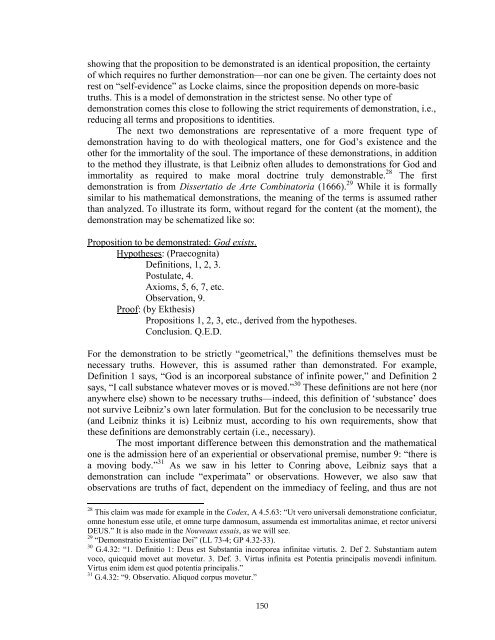Stony Brook University
Stony Brook University
Stony Brook University
Create successful ePaper yourself
Turn your PDF publications into a flip-book with our unique Google optimized e-Paper software.
showing that the proposition to be demonstrated is an identical proposition, the certainty<br />
of which requires no further demonstration—nor can one be given. The certainty does not<br />
rest on “self-evidence” as Locke claims, since the proposition depends on more-basic<br />
truths. This is a model of demonstration in the strictest sense. No other type of<br />
demonstration comes this close to following the strict requirements of demonstration, i.e.,<br />
reducing all terms and propositions to identities.<br />
The next two demonstrations are representative of a more frequent type of<br />
demonstration having to do with theological matters, one for God’s existence and the<br />
other for the immortality of the soul. The importance of these demonstrations, in addition<br />
to the method they illustrate, is that Leibniz often alludes to demonstrations for God and<br />
immortality as required to make moral doctrine truly demonstrable. 28 The first<br />
demonstration is from Dissertatio de Arte Combinatoria (1666). 29 While it is formally<br />
similar to his mathematical demonstrations, the meaning of the terms is assumed rather<br />
than analyzed. To illustrate its form, without regard for the content (at the moment), the<br />
demonstration may be schematized like so:<br />
Proposition to be demonstrated: God exists.<br />
Hypotheses: (Praecognita)<br />
Definitions, 1, 2, 3.<br />
Postulate, 4.<br />
Axioms, 5, 6, 7, etc.<br />
Observation, 9.<br />
Proof: (by Ekthesis)<br />
Propositions 1, 2, 3, etc., derived from the hypotheses.<br />
Conclusion. Q.E.D.<br />
For the demonstration to be strictly “geometrical,” the definitions themselves must be<br />
necessary truths. However, this is assumed rather than demonstrated. For example,<br />
Definition 1 says, “God is an incorporeal substance of infinite power,” and Definition 2<br />
says, “I call substance whatever moves or is moved.” 30 These definitions are not here (nor<br />
anywhere else) shown to be necessary truths—indeed, this definition of ‘substance’ does<br />
not survive Leibniz’s own later formulation. But for the conclusion to be necessarily true<br />
(and Leibniz thinks it is) Leibniz must, according to his own requirements, show that<br />
these definitions are demonstrably certain (i.e., necessary).<br />
The most important difference between this demonstration and the mathematical<br />
one is the admission here of an experiential or observational premise, number 9: “there is<br />
a moving body.” 31 As we saw in his letter to Conring above, Leibniz says that a<br />
demonstration can include “experimata” or observations. However, we also saw that<br />
observations are truths of fact, dependent on the immediacy of feeling, and thus are not<br />
28 This claim was made for example in the Codex, A 4.5.63: “Ut vero universali demonstratione conficiatur,<br />
omne honestum esse utile, et omne turpe damnosum, assumenda est immortalitas animae, et rector universi<br />
DEUS.” It is also made in the Nouveaux essais, as we will see.<br />
29 “Demonstratio Existentiae Dei” (LL 73-4; GP 4.32-33).<br />
30 G.4.32: “1. Definitio 1: Deus est Substantia incorporea infinitae virtutis. 2. Def 2. Substantiam autem<br />
voco, quicquid movet aut movetur. 3. Def. 3. Virtus infinita est Potentia principalis movendi infinitum.<br />
Virtus enim idem est quod potentia principalis.”<br />
31 G.4.32: “9. Observatio. Aliquod corpus movetur.”<br />
150
















